|
|
|
|
 |
BIRDS: Sparrows, House |
|
|
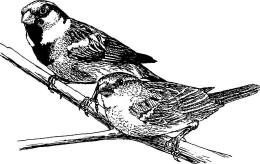
Fig. 1. House sparrow,
Passer domesticus. Male (left) and female (right).
Damage Prevention and Control Methods
Exclusion
Block entrances
larger than 3/4 inch (2 cm).
Design new buildings or alter old ones to eliminate
roosting and nesting places. Install plastic bird
netting or overhead lines to protect high-value crops.
Cultural Methods
Remove roosting
sites. Plant bird resistant varieties.
Frightening
Fireworks, alarm calls, exploders. Scarecrows,
motorized hawks, balloons, kites. 4-Aminopyridine (Avitrol®).
Repellents
Capsicum. Polybutenes. Sharp metal projections (Nixalite®
and
Cat Claw®).
Toxicants
Fenthion in Rid-A-Bird® toxic perches.
Trapping
Funnel,
automatic, and triggered traps. Mist nets.
Shooting
Air guns and small firearms. Dust shot and BB caps.
Other Methods
Nest
destruction. Predators.
Identification
The house or English
sparrow (Fig. 1) is a brown, chunky bird about 5 3/4
inches (15 cm) long, and very common in human-made
habitats. The male has a distinctive black bib, white
cheeks, a chestnut mantle around the gray crown, and
chestnut-colored feathers on the upper wings. The female
and young are difficult to distinguish from some native
sparrows. They have a plain, dingy-gray breast, a
distinct, buffy eye stripe, and a streaked back. The
black bib and chestnut-colored feathers on the wings are
the first signs of male plumage and appear on the young
birds within weeks of leaving the nest.
Range
The house sparrow was
first introduced in Brooklyn, New York, from England in
1850 and has spread throughout the continent.
Habitat
The house sparrow is found in nearly every
habitat except dense forest, alpine, and desert
environments. It prefers human-altered habitats,
particularly farm areas. While still the most common
bird in most urban areas, house sparrow numbers have
fallen significantly since they peaked in the 1920s,
when food and wastes from horses furnished an unlimited
supply of food.
Food Habits
House sparrows are
primarily granivorous. Plant materials (grain, fruit,
seeds, and garden plants) make up 96% of the adult diet.
The remainder consists of insects, earthworms, and other
animal matter. Nestlings, however, are fed mostly animal
matter. Garbage, bread crumbs, and refuse from fast-food
restaurants can support sparrow populations in urban
habitats.
General Biology, Reproduction, and Behavior
Breeding can occur in any
month but is most common from March through August. The
male usually selects a nest site and controls a
territory centered around it. Nests are bulky, roofed
affairs, built haphazardly and without the good
workmanship displayed by other weaver finches, the group
to which the house sparrow belongs. Sparrows are loosely
monogamous. Both sexes feed and take care of the young,
although the female does most of the brooding. From 3 to
7 eggs are laid, 4 to 5 being the most typical.
Incubation takes 10 to 14 days, and the young stay in
the nest for about 15 days. They may still be fed by the
adults for another 2 weeks after leaving the nest.
House sparrows are
aggressive and social, both of which increases their
ability to compete with most native birds. Sparrows do
not migrate. Studies have shown that 90% of the adults
will stay within a radius of 1 1/4 miles (2 km) during
the nesting period. Exceptions occur when the young set
up new territories. Flocks of juveniles and nonbreeding
adults will move 4 to 5 miles (6 to 8 km) from nesting
sites to seasonal feeding areas.
Mortality is highest
during the first year of life. Few sparrows survive in
the wild past their fifth season. One individual,
however, lived in captivity for 23 years. While house
sparrows are tolerant of disturbance by humans, they can
in no way be considered tame. Their success lies in
their ability to exploit new habitats, particularly
those influenced by humans.
Damage
House sparrows consume
grains in fields and in storage. They do not move great
distances into grain fields, preferring to stay close to
the shelter of hedgerows. Localized damage can be
considerable since sparrows often feed in large numbers
over a small area. Sparrows damage crops by pecking
seeds, seedlings, buds, flowers, vegetables, and
maturing fruits. They interfere with the production of
livestock, particularly poultry, by consuming and
contaminating feed. Because they live in such close
association with humans, they are a factor in the
dissemination of diseases (chlamydiosis, coccidiosis,
erysipeloid, Newcastle’s, parathypoid, pullorum,
salmonellosis, transmissible gastroenteritis,
tuberculosis, various encephalitis viruses, vibriosis,
and yersinosis), internal parasites (acariasis,
schistosomiasis, taeniasis, toxoplasmosis, and
trichomoniasis), and household pests (bed bugs, carpet
beetles, clothes moths, fleas, lice, mites, and ticks).
In grain storage
facilities, fecal contamination probably results in as
much monetary loss as does the actual consumption of
grain. House sparrow droppings and feathers create
janitorial problems as well as hazardous, unsanitary,
and odoriferous situations inside and outside of
buildings and sidewalks under roosting areas. Damage can
also be caused by the pecking of rigid foam insulation
inside buildings. The bulky, flammable nests of house
sparrows are a potential fire hazard. The chattering of
the flock on a roost is an annoyance to nearby human
residents.
Nestlings are primarily
fed insects, some of which are beneficial and some
harmful to humans. Adult house sparrows compete with
native, insectivorous birds. Martins and bluebirds, in
particular, have been crowded out by sparrows that drive
them away and destroy their eggs and young. House
sparrows generally compete with native species for
favored nest sites.
Legal Status
The house sparrow is
afforded no legal protection by federal statutes because
it is an introduced species. A few states, however, may
offer them some protection by requiring permits or
otherwise restricting control activities. Check with
state or local governments before poisoning or shooting
house sparrows.
Damage
Prevention and Control Methods
Exclusion
Close all
openings over 3/4 inch (2 cm) to exclude house sparrows
from buildings. Replace the glass in broken windows or
cover them with plywood or wire mesh. Block openings,
like bell towers, with poultry mesh no larger than 3/4
inch (2 cm). Warehouse doorways that must accommodate
human traffic can sometimes be effectively blocked by
hanging a flexible wall of 4- to 6-inch (10-to 15-cm)
plastic strips in front of the opening. These will not
seriously impede human movements yet present an
impassable barrier to sparrows. Poultry houses and
feeders should be screened to exclude sparrows.
Attach signs flat against
buildings to avoid providing roosting sites. Screen or
block spaces between existing signs and buildings.
Install slanted metal, plexiglass, or wooden boards
(>45o angle) over ledges, such as those under shopping
mall overhangs or on old buildings, so sparrows cannot
roost or nest on them. Eaves should be screened if the
birds are able to squeeze into them. Block the spaces
between window air conditioners and buildings to keep
sparrows out. If possible, place fine mesh over
architectural decorations on old buildings to prevent
roosting. It is much more effective, however, to work
with architects on building designs that eliminate
ornamental patterns and holes that provide nest sites
for sparrows.
Prevent house sparrows
from roosting on ivy-covered walls by stringing plastic
bird netting (green or black) over the vines. While not
as satisfactory as removing the shrubbery, the mesh
generally blends in with the plants and still prevents
the birds from roosting and nesting in them. Place
netting in front of ventilator openings to keep birds
out of buildings. Examine ventilators, vents, air
conditioners, building signs, ledges, eaves, overhangs,
ornamental openings, and ornate designs for potential
and existing bird usage and eliminate those sites where
practical.
Protect small crop areas
with plastic bird netting in situations involving
high-value crops, such as grapes, berries, or
experimental grains. This approach can be economical if
netting is used for several years to protect the site.
Leave no openings at the bottom of netted crop areas.
Sparrows that get into fields through such openings and
are unable to find their way out can cause considerable
damage.
House sparrows can be
discouraged at bird feeders by installing vertical
monofilament lines at 2-foot (0.6-m) intervals around
the feeders. Studies have shown that many other species
of birds are not affected. Electric wires can be
installed on perches of feeders to shock house sparrows
when they land. This requires watching the feeder so the
current can be activated only when house sparrows are
attempting to feed.
House sparrows cannot use
bird houses with openings 1 1/8 inches or less (2.8 cm);
this size can be used only by wrens. Sparrows are
attracted to and often colonize martin apartment houses
if they are left unattended. Martin houses should be
placed on tall poles in an unobstructed air space
necessary for their aerial acrobatics. Block the
entrances to martin houses until martin scouts appear in
spring, back from their winter feeding grounds. Lower
and clean the houses at the end of the breeding season.
Bluebirds can be encouraged with nest boxes that have 1
1/2-inch (3.8-cm) entrance holes and a 3 1/2-inch (9-cm)
hole bored in the roof, covered with 1/2-inch (1.3-cm)
mesh. Bluebirds apparently can withstand wetting, but
the sparrows like a tight roof overhead.
Cultural Methods
Destruction of
roosting and nesting sites is one approach to solving a
sparrow problem. Total removal of shrubs or even trees
is an effective but extreme measure. In rural areas,
removal of hedgerows adjacent to crop fields will limit
the attractiveness of the area to house sparrows, but
will also have a negative effect on other wildlife.
Remove dead fronds from palm trees to eliminate roosting
sites.
Several varieties of small
grains are resistant to bird damage. Some sorghum
varieties have a high tannin content in the early growth
stages. Others have loose seed heads, on which sparrows
are unable to perch and feed.
Frightening
No truly
successful alarm or distress calls have been found for
house sparrows. Frightening devices designed for other
species (fireworks, shell crackers, acetylene exploders,
and cymbals) will move sparrows from an area for a short
period. Sparrows, however, adapt quickly to frightening
devices and will not be repelled by sounds for any great
length of time unless the sounds are diversified and
their locations shifted periodically.
Visual frightening devices
can be helpful in some areas where crops are susceptible
to damage for only a short period. Of the “scarecrow”
devices, kites, balloons, and simulated bird of prey
forms that circle above are the most useful. Sparrows
can be frightened temporarily by mylar tape or
shimmering foil strips. Alternate the use of several
audio and visual frightening devices for best control.
4-Aminopyridine (Avitrol®)
is registered as a chemical frightening agent because
the affected birds react so violently to it that the
remainder of the flock is frightened out of the treated
area. Usually large numbers of sparrows die before the
repellent effect is achieved.
Repellents
Spread tactile
repellents such as sticky bird glues on ledges to
prevent roosting. These polybutenes are reasonably
effective for periods of 1 year or more. They are messy
and should be placed on tape or sealed masonry surfaces
so they can be removed. They lose their tackiness after
they become hardened by changing weather or covered by
dust.
More expensive, but longer
lasting than chemicals, are sharp metal projections such
as Nixalite® and Cat Claw®. These sharp metal
projections prevent the birds from roosting comfortably
in an area. Sparrows can roost on ledges only 1 1/2
inches (3.8 cm) wide. Therefore, ledges and other niches
must be completely covered. Placing monofilament lines
at 1-to 2-foot (0.3- to 0.6-m) intervals may help to
repel house sparrows from roosting sites. Electrified
wires strung over roost sites have been effective, but
it is an expensive alternative.
Granular formulations of
capsicum are federally registered for repelling sparrows
from certain fruits, vegetables, and grain crops. Read
the product label for specific information.
Toxicants
Fenthion is the
only toxicant registered for controlling house sparrows.
It is applied by using Rid-A-Bird® perches. These metal
perches have a wick in the center that delivers the
liquid toxicant to the feet of birds as they perch. The
habits of the birds in individual situations must be
studied to determine the most effective placement of the
perches. This is an effective and reasonably selective
method when used inside buildings. Use extreme care to
avoid spillage of the toxicant. Fenthion can be absorbed
through the skin, so applicators must be aware of the
toxicity hazards.
State pesticide
registrations vary. Check with your local extension or
USDA-APHIS-ADC office for information on toxicant and
repellent use in your area.
There are no fumigants
registered for use against sparrows.
Trapping
Trapping is
probably the most widely used method in attempting to
reduce house sparrow populations in a small area. As
most bird traps normally are live traps, nontarget
species can be released unharmed. There are more types
of traps available for sparrows than for any other bird.
Sparrows that have been trapped once often become
trap-shy. Therefore, traps alone are insufficient to
remove an entire sparrow population.
Funnel Traps. These are
the most commonly used traps available (Fig. 2). While
funnel traps are probably the most easily entered of any
trap, sparrows can also escape from them with relative
ease. Thus, they should be checked frequently and the
birds removed. Where possible, decoy individuals should
be penned in separate compartments inside these traps
Automatic Traps. These are
counterbalanced multicatch traps (Fig. 3). House
sparrows enter a compartment alone to feed on bait that
is placed on a shelf in the trap. Their weight causes an
“elevator” to drop to the lower level where the bird
“escapes” into a closed cage. Without the bird’s weight,
the counterbalanced “elevator” springs back into the
original position ready for another passenger. It is
more difficult to entice the birds into this type of
trap than into the funnel traps, but the final catch is
probably greater as it is almost impossible for the
sparrows to escape.
Triggered Traps. These
traps are limited by the number of house sparrows they
can catch at one time (Fig. 4). In some cases the traps
are not automatic and consequently require a watcher to
tend them and spring them at the proper moment. The
“clap trap” is one of the oldest bird traps, used first
by ancient Egyptians.
Mist Nets. A final method
of trapping is to entangle flying house sparrows in a
fine net known as a mist net. Mist nets are placed
across the flight paths of the birds in front of a dark
background. The nets cannot be seen until the birds
blunder into them, become entangled, and are unable to
extricate themselves. Mist nets also require
considerable amount of time to set up and tend, and they
are illegal in some states. Federal permits are required
for trapping birds in mist nets. Nontarget species may
be captured and must be removed and released
immediately.
Shooting
Shooting with
air guns or low-powered firearms can be used with some
success where local ordinances permit. Sparrows quickly
become wary of a human holding anything resembling a
firearm, so shooting from a blind is recommended
whenever possible. An old method is to place grain in a
windrow and shoot into a baited flock with an open-choke
shotgun. Special ammunition known as “dust shot” (a .22
long rifle shell filled with No. 10 shot) or “BB caps”
(a lead slug in a short .22 shell) are available. The
effective range of these specialized tools, however, is
extremely limited.
Other Methods
Nest
Destruction. Discourage house sparrows from using an
area by removing nests and destroying the eggs and/or
young. House sparrows are very persistent, so this
operation must be repeated at 2-week intervals
throughout the breeding season. Use a long insulated
pole with a hook attached to one end to remove nests
that are located in high places. Nest destruction is
also recommended in shopping malls and around building
signs in urban areas. The nesting materials should be
collected and removed to make it harder for the birds to
find materials for new nests.
Predators. Cats and
sparrows are both abundant in the same human-altered
habitat. A study in one English village found house cats
reduced a resident house sparrow population by 80%
during a year. One farmer has devised a system using
predation to control house sparrows by building catwalks
around the inside of his barn at rafter level. Scrap
lumber was used to provide his farm cats access to
locations where sparrows usually roosted or nested. Once
the cats were able to patrol the barn, the sparrows
quickly vacated the building.
Economics of Damage and Control
Barrows (1889) published
the results of a US Department of Agriculture survey
concerning the status of house sparrows in 1886, about
35 years after their successful introduction. By this
time, house sparrows were recognized as a detriment to
agriculture and native birds. Kalmbach (1940) analyzed
8,004 sparrow stomachs and found that only 20% of the
foods (primarily insects) taken by adult sparrows were
beneficial to humans, 25% were of neutral importance,
and 55% were definitely detrimental to human interests.
While 59% of nestling foods were beneficial to humans
and only 28% injurious, he pointed out that their impact
lasted for only 10 to 12 days.
A recent survey of bird
problems across the United States indicated that 25% of
the respondents in cities had problems with house
sparrows, behind pigeons (71%), blackbirds (54%), and
starlings (42%) (Fitzwater 1988). Extensive measures
with traps are not cost-effective.
Side

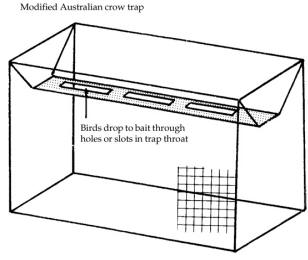
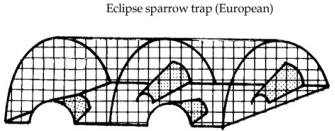
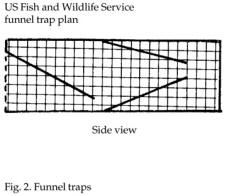
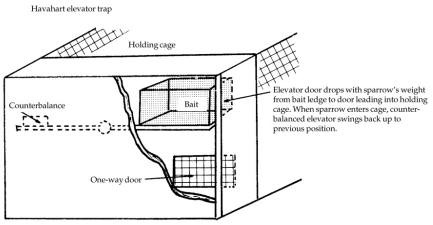 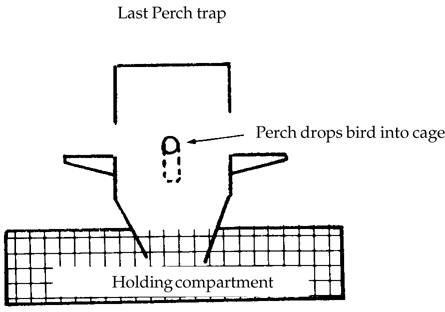
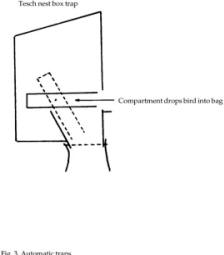 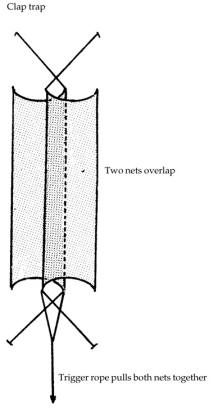
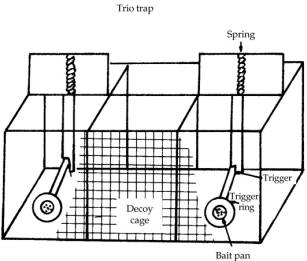
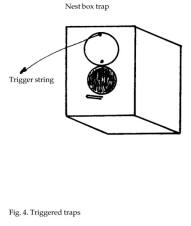
Acknowledgments
Figure 1 by Emily Oseas
Routman.
Figures 2 through 4 by the
author, adapted by Jill Sack Johnson.
For Additional Information
Barrows, W. B. 1889. The
English sparrow (Passer domesticus) in North America. US
Dep. Agric., Div. Econ. Ornith. Mammal., Bull. No. 1,
Washington, DC. 405 pp.
Bent, A. C. 1958. Life
histories of North American blackbirds, orioles,
tanagers, and allies. US Natl. Museum Bull. 211,
Washington, DC. pp. 1-27.
Churcher, P. B., and J. H.
Lawton. 1987. Predation by domestic cats in an English
village. J. Zool. (London) 212:439-455.
Dearborn, N. 1927. The
English sparrow as a pest. US Dep. Agric. Farmer’s Bull.
493, Washington, DC. 22 pp.
Fitzwater, W. D. 1982.
Outwitting the house sparrow [Passer domesticus (Linneaus)].
Proc. Great Plains Wildl. Damage Control Workshop
5:244-251.
Fitzwater, W. D. 1988.
Solutions to urban bird problems. Proc. Vertebr. Pest
Conf. 13:254-259.
Grussing, Don. 1980. How
to control house sparrows. Roseville Publ. House,
Roseville, Minnesota. 52 pp.
Kalmbach, E. R. 1940.
Economic status of the English sparrow in the United
States. US Dep. Agric. Tech. Bull. 711, Washington, DC.
66 pp.
Kessler, K. K., R. J.
Johnson, and K. M. Eskridge. 1991. Lines to selectively
repel house sparrows from backyard feeders. Proc. Great
Plains Wildl. Damage Control Workshop. 10:79-80.
Neff, J. A. 1937.
Procedure and methods in controlling birds injurious to
crops in California. Part II: Control methods. Mimeo, US
Dep. Agric. and California State Dep. Agric.,
Sacramento. 153 pp.
Royall, W. C., Jr. 1969.
Trapping house sparrows to protect experimental grain
crops. US Dep. Inter. Bureau Sport Fish. Wildl., Wildl.
Leaflet 484, Washington, DC. 10 pp.
Stokes, D. W. 1979. A
guide to the behavior of common birds. Little, Brown and
Co., Boston. 336 pp.
Summers-Smith, D. 1963.
The house sparrow. Collins, London. 269 pp.
Thearle, R. J. P. 1968.
Urban bird problem. Pages 181-197 in R.K. Murton and E.N.
Wright, eds. The problems of birds as pests. Academic
Press. New York.
Weber, W. J. 1979. Health
hazards from pigeons, starlings and English sparrows.
Thomson Publ., Fresno, California. 138 pp.
Wright, E. N., I. R.
Inglis, and C. J. Feare, 1980. Bird problems in
agriculture. The British Crop Protect. Council, Croydon,
United Kingdom. 210 pp.
Editors
Scott E. Hygnstrom Robert
M. Timm Gary E. Larson
PREVENTION AND CONTROL OF
WILDLIFE DAMAGE — 1994
Cooperative Extension
Division Institute of Agriculture and Natural Resources
University of Nebraska -Lincoln
United States Department
of Agriculture Animal and Plant Health Inspection
Service Animal Damage Control
Great Plains Agricultural
Council Wildlife Committee
04/05/2006
Special
thanks to:
Clemson University
|